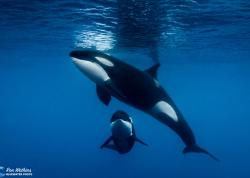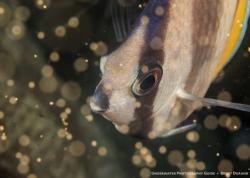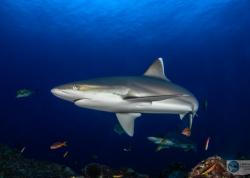January Critter Season
January Critter Season!
While water temperatures may be cold, this is arguably the best time of year for critter action & underwater photography
by Mike Bartick
Someone once said to me, “Eating at my favorite restaurant every night would get boring." Being a creature of habit I’ve had to rebut that statement for a long time. Finding myself staring into the surf line rolling into one of my favorite dive sites, I think about that statement and wonder if diving at my favorite dive sites could get boring? No way!
Sea creatures come and go, aquatic plants and even topography changes. Just like the terrestrial seasons, the ocean also has its seasonal moods, a certain rhythm that only Mother Nature can orchestrate.
These changes on dive sites in the Indo-Pacific are very similar to those I see at home in the Eastern Pacific. The cool waters of January and February coupled with changing wind direction seem to turn the water over and replenish the seas on both sides of the Pacific.
Underwater critter hunting in January
January is a wonderful time to hunt critters for several reasons, but the best is that there is usually an abundance of activity. It seems each January we find more critters with eggs than during any other time of year.
Shrimp, crabs, and squat lobsters are all critters I love to photograph. Challenging to shoot indeed, some of them are even more challenging to find. Here are a few methods I use when trying to locate such creatures (besides hiring the right guides).
The first tool in my box is observation, which is something we are all capable of and can really pay off. Seeing nervous damsel fish or crazed nemos can definitely indicate that they are trying to protect something, namely eggs. I look for bare wire coral on dive sites that damsel fish love to use to lay and tend their eggs.


This excited Damsel fish tends to her newly laid eggs on this otherwise barren wire coral.
This January in particular has been unusually good for finding nemo eggs. It seemed like every few days I found another patch of fresh eggs being protected by a veritable hornet nest of activity.

Macro shot of the nemo eggs reveals the undeveloped hatchlings complete with inquisitive eyes.
Nemo eggs are usually laid on a rocky patch just under the edge of the anemones. Ask your guide for assistance on this as they will know where the eggs are. Reckless examination of anemones will kill both the anemone and eggs.
Swimming crabs make great subjects, but are too often living under sea cucumbers or near tube anemones. I was lucky enough to discover this swimming crab was protecting something valuable.

Swimming crab snaps at me in defense, protecting its clutch of eggs

Many of the sea cucumbers host imperial shrimp and/or these tiny ornate swimming crabs.
Night dives offer some wonderful opportunities to shoot squat lobsters and a variety of shrimp that are not normally seen during the daylight hours. Purple barrel sponges become a whole ecosystem while crinoids and even nudibranchs all seem to have hitchhikers.

This squat lobster is often mistaken as a hairy crab; squat lobsters usually have two longer claspers up front than crabs do and often “squat” on their tails.

The elegant crinoid squat lobster is often found under the crinoid itself, but when disturbed this squatty will retreat to the safety of the crinoid, becoming wrapped up and very difficult to coax out without injury.
The coveted bumblebee shrimp are often found in very shallow water and are a tough subject to photograph. I have shot and re-shot these little fellows and still haven’t been able to nail the perfect photo. The bumblebee shrimp is named thus not only because of their coloration but also the way they seem to fly underwater!

The bumblebee shrimp is high on the “holy grail” list for macro photographers and remains near the top of mine.
No article would be complete without at least a couple octopus photos. The cooler waters often bring out the blue ringed octopus. These guys are not only tough to find but they tend to be very shy. Once engaged they will become playful, but getting them to play is no easy task!

Blue ring octopi are found all over the Indo-Pacific and Australia. They are extremely venomous and should not be handled.
The coconut octopus is a common but very entertaining octo found on many sandy muck dive sites throughout the Indo-Pacific and South East Asia. Their animated antics are fun to watch and photograph on both day and night dives. Collecting shells, discarded bottles or various other items seems to be the favorite past time of with these guys. They use these items to build their homes and are often seen moving along the ocean floor with different items in tow.

Soft snooted lighting helped to capture the playful but cautious mood of this interesting creature.
Often it's the more common critters I overlook that are the most compelling to photograph. Swimming away from something I have photographed before or just ignoring it altogether may be exactly the kind of attitude my buddy was talking about when he referred to his favorite restaurant.
Remember when you’re out there looking for critters, do your homework first. Check the food sources in the books first (if available) before looking for them in nature.
Diving my favorite dive sites on a regular basis has allowed me an upclose and intimate knowledge of the reefs, animals and their behaviors. It’s an amazing experience to see the things that only we divers get to see. I couldn’t imagine my life without it! January waters may be chilly but the critter action will keep your insides warm and fuzzy!
Now get out there and have an adventure!
About the author
Mike Bartick is an avid and experienced scuba diver, and Marine Wildlife Photographer. He has an insatiable love for nudibranchs, frogfish, and other underwater critters, and he is the official critter expert for Underwater Photography Guide. See more of Mike's underwater photos at www.saltwaterphoto.com, and at www.thecritterhead.com.
Further reading
Support the Underwater Photography Guide
Please support the Underwater Photography Guide by purchasing your underwater photography gear through our sister site, Bluewater Photo & Video. Click, or call them at (310) 633-5052 for expert advice!
RECOMMENDED ARTICLES
SUPPORT THE UNDERWATER PHOTOGRAPHY GUIDE:
The Best Service & Prices on u/w Photo Gear
 Visit Bluewater Photo & Video for all your underwater photography and video gear. Click, or call the team at (310) 633-5052 for expert advice!
Visit Bluewater Photo & Video for all your underwater photography and video gear. Click, or call the team at (310) 633-5052 for expert advice!
The Best Pricing, Service & Expert Advice to Book your Dive Trips
 Bluewater Travel is your full-service scuba travel agency. Let our expert advisers plan and book your next dive vacation. Run by divers, for divers.
Bluewater Travel is your full-service scuba travel agency. Let our expert advisers plan and book your next dive vacation. Run by divers, for divers.
































